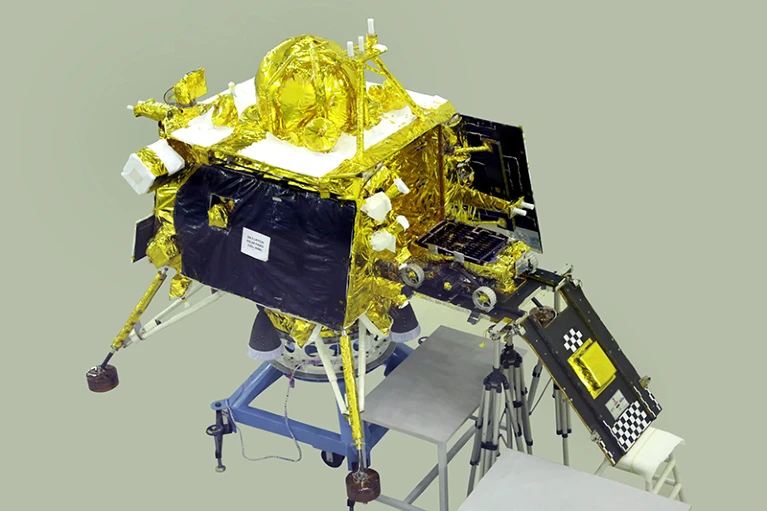The Moon’s south pole is in India’s sights as the nation prepares to launch a robotic lander and explorer.
India is preparing to launch a spacecraft carrying a lander to the Moon on 14 July. If the mission is successful, India will become only the fourth country ever to make a controlled lunar landing, after the United States, the former Soviet Union and China. The 6-billion-rupee (US$73-million) mission, called Chandrayaan-3, is the second attempt by the Indian Space Research Organisation (ISRO) to land a craft safely on the Moon.
Chandrayaan-3 will send a lander and rover from the spaceport of Sriharikota, off India’s east coast, to a site near the Moon’s south pole. After the craft lands, scientists at ISRO plan to deploy the rover to study the Moon’s properties. If successful, the mission will be first to land in the vicinity of the south pole; previous Moon missions have landed at lower latitudes.
ISRO says that the lunar south pole is of special interest because parts of it remain permanently in shadow, raising the possibility of sampling Moon ice for the first time. Moreover, the large craters near the lunar south pole might contain clues to the composition of the early Solar System.
“The south pole region has very different geology from the region around the [US] Apollo missions, so Chandrayaan-3 will provide a close-up view of an entirely new region of the Moon,” says planetary geochemist Marc Norman at the Australian National University in Canberra.
A successful landing could also be an important step towards future Indian Moon missions and is seen as a demonstration of India’s growing geopolitical ambitions.
India’s Moon missions
Chandrayaan-3 follows the successful lunar orbiter Chandrayaan-1, launched in 2008, and the partially successful Chandrayaan-2, in 2019. The second mission successfully launched a lunar orbiter with eight functioning instruments, but the lander carrying the rover crashed into the Moon during the final moments of its descent in September 2019.
ISRO chairman Sreedhara Somanath said recently that the crash was due to a software error.
India’s third Moon mission will focus on the Moon landing. A three-stage rocket will place Chandrayaan-3 into an elliptical parking orbit of approximately 170 kilometres by 36,500 km. A two-tonne propulsion module will then bring the lander–rover complex into a circular orbit at about 100 km from the Moon’s surface. The 1.75-tonne lander, named Vikram, contains a 26-kilogram, six-wheeled robotic rover called Pragyan that is designed to ramble around the Moon for the equivalent of about 14 days on Earth.
ISRO engineers and scientists say they have made changes to the software and hardware of the Chandrayaan-3 mission, especially for the lander thrusters, in the wake of the problems with Chandrayaan-2. ISRO has developed improved soft-landing sequences and the lander has four thruster engines instead of five, sturdier legs and larger solar panels, and will carry more fuel.
ISRO has not publicly released a report analysing the failure of Chandrayaan-2. But a retired ISRO engineer has said that the cause was insufficient ‘throttling’ — gradual reduction in speed — by the engines, a crucial requirement during lunar descent.
Moon science
The propulsion module will serve as a communications relay satellite, and the orbiter from Chandrayaan-2 will be used as a backup relay. The propulsion module has one instrument, the Spectro-polarimetry of HAbitable Planet Earth (SHAPE), to gather data on the polarization of light reflected by Earth so that researchers can look for other planets with similar signatures.
The lander will be equipped with instruments that will measure the density of ions and electrons near the surface of the Moon and how this changes over time; measure the temperature of the Moon’s surface; scan for moonquakes; and investigate the dynamics of the Moon system.
Similar measurements were made by the US Apollo and Chinese Chang’e missions when they landed nearer the Moon’s equator, but this will be the first analysis of the environment at one of the poles. Thermal conductivity in particular depends on the grain size and packing of regolith — the surface layer of loose rubble — and so will be useful for characterizing the landing site, Norman says. Such data cannot be obtained from orbit. “And any time you study a new area, there is always the possibility of discovering something unexpected,” he says.
Although the science goals might be relatively modest, “The mission is seen as a critical step toward future operations on the lunar surface, both manned and robotic,” says Tomas Hrozensky at the European Space Policy Institute in Vienna. He says Chandrayaan-3 will help to achieve the goal of establishing a long-term presence of humans on the Moon and other planets. “Recent examples, with a few failures, suggest that landing and a long-term presence on the Moon remain an immense challenge.”
If successful, India’s Moon landing will have “important technological and geopolitical dimensions, arguably without a dramatic impact on foundational scientific knowledge,” says Hrozensky.
“Landing on the Moon continues to be a highly valued political target for some nations.”
doi: https://doi.org/10.1038/d41586-023-02217-0
- Adenman
-

 1
1



Recommended Comments
There are no comments to display.
Join the conversation
You can post now and register later. If you have an account, sign in now to post with your account.
Note: Your post will require moderator approval before it will be visible.